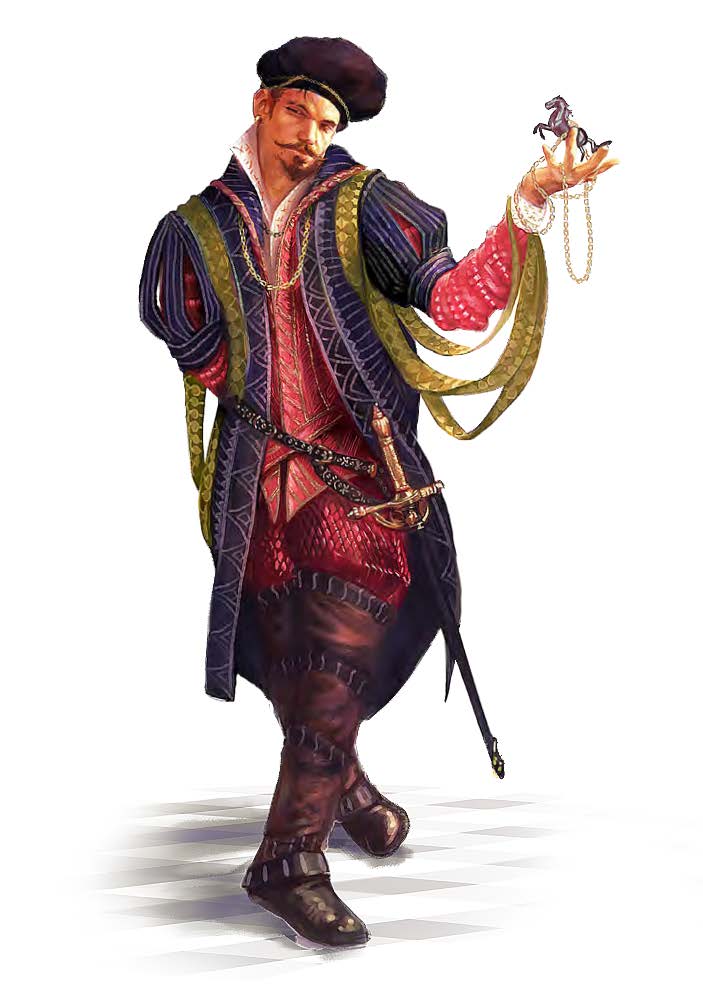
Your players are about to begin their first session of a roleplaying game!
“I’ve played games where you play a part before. Just last week, I played the Scottie dog running all around Boardwalk!”
As the game master (GM) for new players, you have the responsibility to not only explain the structure and rules of the game but also the expectations of the players in a roleplaying game. For players whose only experience is with board games and video games, roleplaying opens up a whole new world, and you are their guide.
The first thing that players need to understand before they play is the idea of playing their part. Before you even begin to explain the rules of the game, they need to understand this. This is what defines roleplaying games as distinct from board games and video games. In a board game, you play as yourself, trying to reach some goal before the other players—to win. Even in video games, where you might create or choose a character, your choices are limited by the game’s framework, and ultimately you are trying to win as a player. Unlike either of these situations, a roleplaying game means you make decisions not based on what you would personally do in a given situation but instead based on what your character would do, based on their background and personality.
As a GM, you can set the expectations for a roleplaying game with a metaphor. Although roleplaying games are a type of game, it’s more valuable to compare them to writing a script as a group. The GM and players are creating a story together. Each player creates a character and writes their part, the actions they take and the words they speak. The GM creates the other characters and writes their parts as well as the narration and the scenes.
As the GM, you can introduce your players to roleplaying in the first session, which ideally is a “session zero.” A session zero is an introduction to a campaign where the GM describes the campaign setting and adventure goals and the players create their characters. Even if you are running a single session adventure, you’ll need an introductory part of the session to describe the game. In this introduction period, you’ll set expectations for the players. Since your players are new to roleplaying, you will describe the player’s role as mentioned above. However, the best method of explaining the player’s role is with a demonstration.
You can do this in an introductory session with a short roleplaying exercise, based in the starting location for your adventure. Whether you start in a tavern, an adventuring guild, or wherever, you’ll need to begin the story with how and why the characters are together. Take turns going around the group, letting the players name and describe their characters in a sentence or two. Then describe the starting location and the current situation.
“You are all patrons at the Golden Oak, a local tavern. There’s an entertainer in the corner, singing lively songs while juggling several fruits.”
At this point, ask each player to tell the group, in a few sentences, why they are in the Golden Oak. You can encourage creative character development with prompts. Is the character native to this city? Why has the character traveled here, and what are they seeking? Is the character excited? Nervous? Suspicious? At this point, the players will begin to understand the creative experience of a roleplaying game. You can then demonstrate that the players are creators in this world as well. Assume you have decided that the story will begin with a mysterious person attacking the entertainer. This will start off the adventure with the characters involved in a plot where the local thieves’ guild is trying to gain control of this city district. So how will you involve the players?
Instead of describing the mysterious person and his attack on the entertainer, let the players help fill in the details. The wizard notices a mysterious figure in the corner of the tavern who is intently watching the entertainer. Ask the wizard’s player what makes the figure seem mysterious. Ask the barbarian’s player what type of creature the mysterious figure is. Now, the mysterious figure quickly rises and streaks toward the entertainer in an apparent attack. Ask the cleric’s player how the mysterious figure attacks. Do they use a weapon? A net? Do they attempt to grapple? You’ve just advanced your plot as needed, but you’ve also made the players part of the storytelling experience. They will realize that roleplaying is about creation as much as rolling dice and deciding what action to take in combat.
As the game moves forward, the players may get wrapped up in the mechanics of the game, such as succeeding in combat and solving puzzles. At times, you will have to make sure they stay on track with playing a character instead of always choosing the tactically advantageous action. Do this by asking questions that emphasize thinking from the point of view of a character.
“The rogue is about to throw the sheriff off the tower wall. As a priest of the goodly way, what would your character do at this point?”
By framing the question to emphasize the player’s character, you’ve now issued a gentle reminder that the player should act from their character’s point of view, not their own.
As a GM, your first responsibility is to make sure the players (including you) have fun. By demonstrating the unique aspects of roleplaying games, you can encourage creativity that will make the game that much more fun for your players and inspire you as well!


This is a great technique, and not just for new players. It also helps to keep players engaged if you’re on a VTT, and once it becomes a habit it just works everywhere.
Good point. Engagement in a vtt is an upcoming post. Thanks for reading.